Concepts of Dishonest Dealer
A dishonest dealer is person who gives less weight than actual. So, he gains in weight (weight gain).
If a dishonest dealer sells his product at CP, weight gain will the the only profit. But if he sells the product at a certain profit percentage on CP (monetary gain), his overall profit will be net effect of weight gain and monetary gain.
Methods of Solving Problems on Dishonest Dealer
To solve such problems there are multiple ways. Use whatever is convenient to you.
I personally prefer Method 2: #Quantity – Price
Question: A dishonest shopkeeper sells sugar at Rs. 18/kg which he has bought at Rs. 15/kg and he is giving 800 gm instead of 1000 gm. Find his actual profit percentage.
Ans: 50%
Explanation:
Method 1: Using ab Method
CP = 15, SP = 18
Monetary gain = \displaystyle\frac{3}{15}\times 100 = 20\%
\boxed{\text{Weight Gain} = \frac{\text{Error}}{\text{Faulty weight}}\times 100}He is giving 800 gm instead 1000 gm
Error = (1000 – 200) gm = 200 gm
Faulty weight = 800g
Weight gain = \displaystyle\frac{200}{800}\times 100 = 25\%
Now applying ab method
(Monetary gain, weight gain) \rightarrow profit
(20, 25) \rightarrow 20 + 25 + \displaystyle\frac{20\times 25}{100} = 50%
Method 2: #Quantity – Price
You may consider reading the concept before jumping to solution if you have not gone though this already.
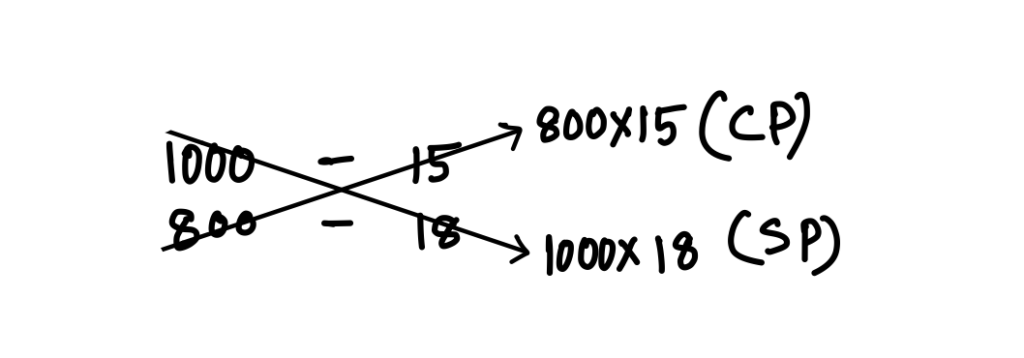
P% = \displaystyle\frac{1}{2}\times 100 = 50\%
Method 3: Using Formula
Overall profit calculation without calculating weight gain
\boxed{\frac{100+\text{G}}{100+\text{x}} = \frac{\text{True weight}}{\text{False weight}}}Here, G = overall gain and x = monetary gain/loss%
We have already solved for x = 20%
So, \displaystyle\frac{100+\text{G}}{100+20} = \displaystyle\frac{1000}{800}
⇒ \displaystyle\frac{100+\text{G}}{120} = \displaystyle\frac{5}{4}
⇒ 100 + G = 150
⇒ G = 50
Actual profit percentage = 50%
Method 4: General approach
For 1kg, CP = 15 and SP = 18
Now, for 800 gm, CP = \displaystyle\frac{15}{1000}\times 800 = 12 (Here we have calculated the CP of 800 gm sugar because the shopkeeper is actually selling only 800gm.)
He is selling 800 gm sugar for Rs 18 for which he had paid Rs 12.
So, P% = \displaystyle\frac{6}{12}\times 100 = 50\%
Question: A shopkeeper claims that he is selling sugar at Rs 23/kg which cost him Rs 25/kg but he is giving 800gm instead of 1000gm. What is his percentage profit or loss?
Ans: 15% profit
Explanation:
SP = 23, CP = 25
L% = \displaystyle\frac{2}{25}\times 100 = 8\%
Weight gain = \displaystyle\frac{200}{800}\times 100 = 25\%
Applying ab method,
(-8, 25) \rightarrow -8 + 25 + \displaystyle\frac{-8\times 25}{100} = 15%
Hence his percentage profit is 15%.
Question: A dishonest dealer professes to sell his goods at a loss of 10% but uses a weight of 800gm instead of 1 kg. Find his profit or loss%.
Ans: 12.5% profit
Explanation:
Monetary loss = 10%
Weight gain = \displaystyle\frac{200}{800}\times 100 = 25\%
Applying ab method,
(-10, 25) \rightarrow -10 + 25 + \displaystyle\frac{-10\times 25}{100} = 12.5%
Practicing problems
Question: A shopkeeper uses 940 gm in place of one kg. He sells it at 4% profit. What will be the overall profit?
(a) 10.4%
(b) 10.6%
(c) 10.8%
(d) 10.9%
Ans: (b) 10.6%
Explanation:

P% = \displaystyle\frac{5}{47}\times 100 = 10.63\% = 10.6\% (rounding off to 1 decimal)
Question: A dishonest dealer sells products at 10% loss on cost price but uses 2 gm instead of 4 gm. what is his profit or loss percent?
(a) 80% profit
(b) 80% loss
(c) 90% profit
(c) 10% loss
Ans: (a) 80% profit
Explanation:
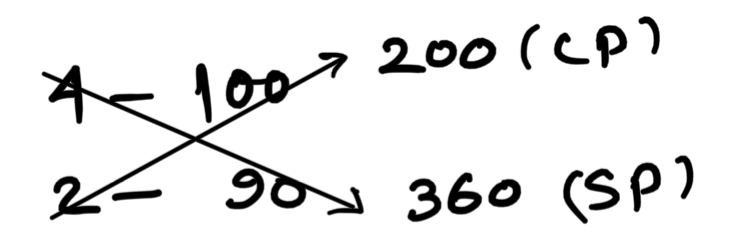
P% = \displaystyle\frac{160}{200}\times 100 = 80\%
Question: A dishonest merchant sells his grocery using weights 15% less than the true weights and makes a profit of 20%. Find his total gain percentage.
(a) 40%
(b) 40.17%
(c) 41%
(d) 41.17%
Ans: (d) 41.17%
Explanation:
Let us assume his CP/100g = ₹100
So, his SP/85g = ₹120
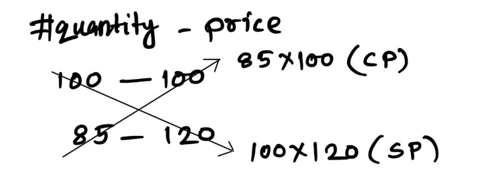
P% = \displaystyle\frac{7}{17}\times 100 = 41.17\%
Question: A shopkeeper sells an item at a profit of 20 % and uses a weight which is 20% less. Find his total profit.
(a) 40%
(b) 45%
(c) 50%
(d) 60%
Ans: (c) 50%
Explanation:
Let us assume his CP/100g = ₹100
So, his SP/80g = ₹120
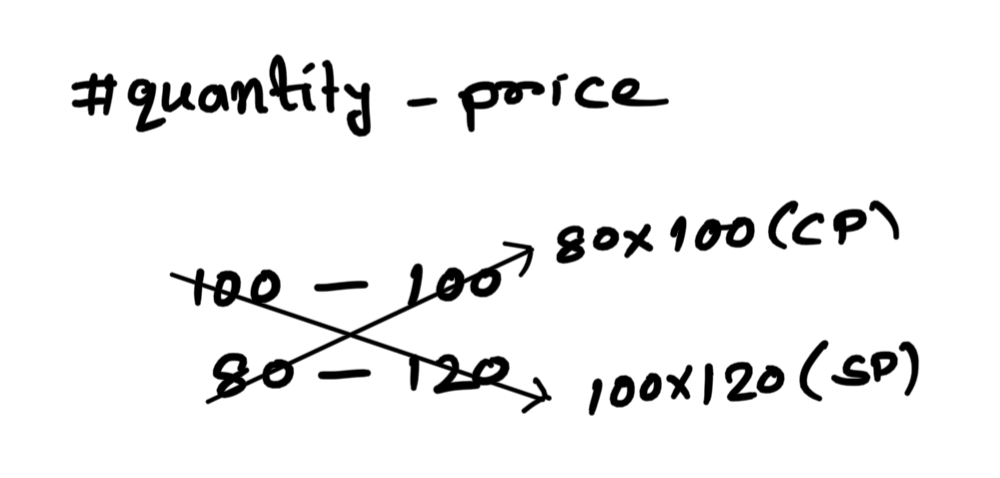
P% = \displaystyle\frac{1}{2}\times 100 = 50\%
Question: A dishonest dealer sells goods at 10% loss on cost price but uses 20% less weight. Calculate profit percent.
(a) 10%
(b) 8%
(c) 12.5%
(d) none of above
Ans: (c) 12.5%
Explanation:
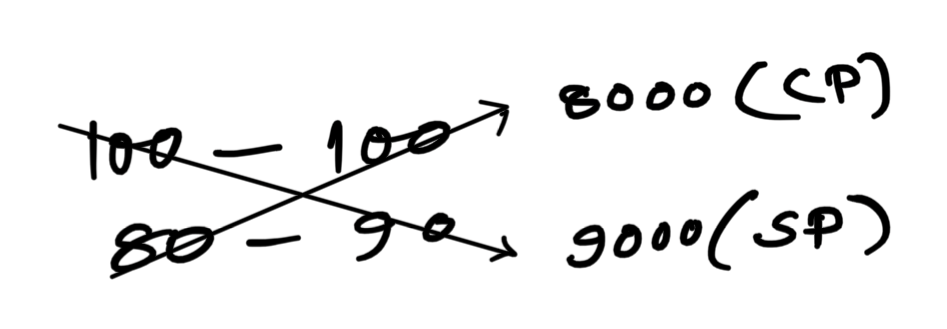
P% = \displaystyle\frac{1000}{8000}\times 100 = 12.5\%
Question: A dishonest dealer professes to sell his good at cost price but uses a false weight and thus gains 20%. For a kilogram he uses a weight of
(a) 700g
(b) 750g
(c) 800g
(d) None of these
Ans: (d) None of these
Explanation:
Weight gain = \displaystyle\frac{\text{Error}}{\text{Faulty wiight}}\times 100
Let, faulty weight is x g
So, \displaystyle\frac{1000-x}{x}\times 100 = 20
⇒ 5000 – 5x = x
⇒ 4x = 5000
⇒ x = 833.33
Question: A dishonest shop keeper professes to sell his goods at the cost price but uses faulty measure. His 1 kg weight measures 950g only. Find his gain/loss percentage?
Ans: 5\displaystyle\frac{5}{19}\% profit
Explanation:
Weight gain = \displaystyle\frac{50}{950}\times 100 = 5\displaystyle\frac{5}{19}\%
Question: A grocery dealer cheats to the extent of 10% while buying as well as selling by using false weight. What is his increase in the profit %?
(a) 20%
(b) 21%
(c) 22%
(d) None of these
Ans: (b) 21%
Explanation:
He has monetary gain of 10% and also weight gain of 10%
Net gain by applying ab method (10, 10) \rightarrow 10 + 10 + \displaystyle\frac{10\times 10}{100} = 21
Question: A dishonest shopkeeper, using a faulty balance makes a profit of 5% while buying as well as while selling his goods. His actual gain percent in the whole process amounts to
(a) 11
(b) 10
(c) 10.25
(d) 10.5
Ans: (c) 10.25
Explanation:
By applying ab method
(5, 5) \rightarrow 10 + 0.25 = 10.25
Question: Lalit marks up his goods by 40% and gives a discount of 10%. Apart from this, he uses a faulty balance also, which reads 1000 gm for 800 gm. What is his net profit percentage?
Ans: 57.5%
Explanation:
Applying ab method,
(MP, discount) \rightarrow P%
(40, -10) \rightarrow 30 – 4 = 26%
Weight gain = 25%
Again, applying ab method for overall profit,
(26, 25) \rightarrow 51 + \displaystyle\frac{26\times 25}{100} = 51 + 6.5 = 57.5%
Question: A shopkeeper wants to make some profit by selling rice. He contemplates about various methods. Which of the following would maximize his profit?
I. Sell rice at 15% profit.
II. Use 850 g of weight instead of 1 kg.
III. Mix 15% impurities in rice and selling rice at cost price.
IV. Increase the price by 7.5% and reduce weights by 7.5%.
(a) I or III
(b) II
(c) II, III and IV
(d) Profits are same
Ans: (b) II
Explanation:
Case-I: Profit % = 15%
Case-II: Faulty weight is used
Weight gain = \displaystyle\frac{\text{Error}}{\text{Faulty weight}}\times 100 = \displaystyle\frac{150}{850}\times 100 = 17.64\%
Case-III: Let, CP of 1kg = Rs. 100
He adds 15% impurities
After adding impurities,
CP of 1 kg = \displaystyle\frac{1150}{100}\times 1000 = 86.95
SP of 1 kg = 100
P% = \displaystyle\frac{13.05}{86.95}\times 100 = 15\%
Case-IV:
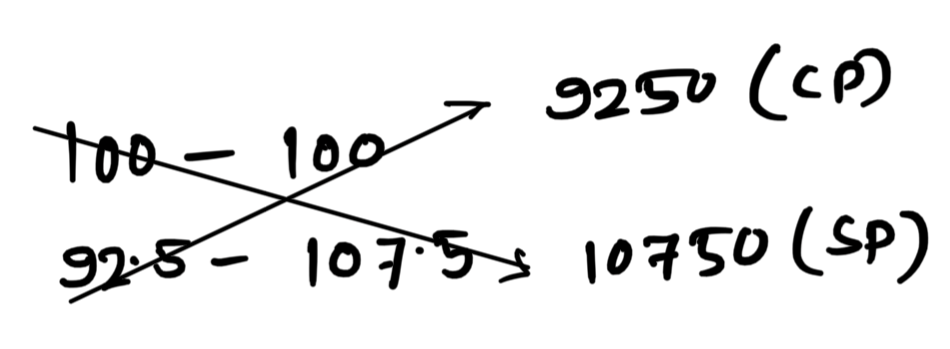
P% = \displaystyle\frac{6}{37}\times 100 = 16.21\%
Now profit summary:
Case-I \rightarrow 15%
Case-II \rightarrow 17.64%
Case-III \rightarrow 15%
Case-IV \rightarrow 16.21%
So, maximum profit at Case-II
Hence (b) is the correct answer
You may like to read our other post on Profit and Loss from here.

Pingback: Profit and Loss - Practice Problems and Solutions
Awesome post. In detailed and with multiple methods.
Happy Reading!💗
Let’s spread the love! Tag a friend who would appreciate this post as much as you did.
Pretty! This has been a really wonderful post. Many thanks for providing these details.
hi! can you explain this formula in detail as per the question 1?
(Monetary gain, weight gain) → profit
I understand that 20% gain is applied on the 25% weight gain to obtain the total gain of 50% but I am unable figure out on which values the percentages are applied to get the final gain.
If you have idea on ab method you could relate that It in the formula a=Monetary gain and b=weight gain. In calculation only numerical values (say 20 for 20% and 25 for 25%) are taken but the numerical result is in percentage.
thanks so much!
If we do not want to use the ab method there, is there any other way to solve the remaining problem after calculating monetary and weight gain?
If you don’t want to apply ab method, then why would you find out monetary and weight gain? Go with any other method. Method 2: #Quantity – Price is robust and has application in other situation also. You may go with that.
got it .
thank you!
thanks so much!
If we do not want to use the ab method there, is there any other way to solve the remaining problem?
Hello my family member! I wish to say that this article is awesome, nice written and include approximately all vital infos. I would like to look more posts like this .
I was suggested this website by my cousin. I am not sure whether this post is written by him as no one else know such detailed about my trouble. You are incredible! Thanks!